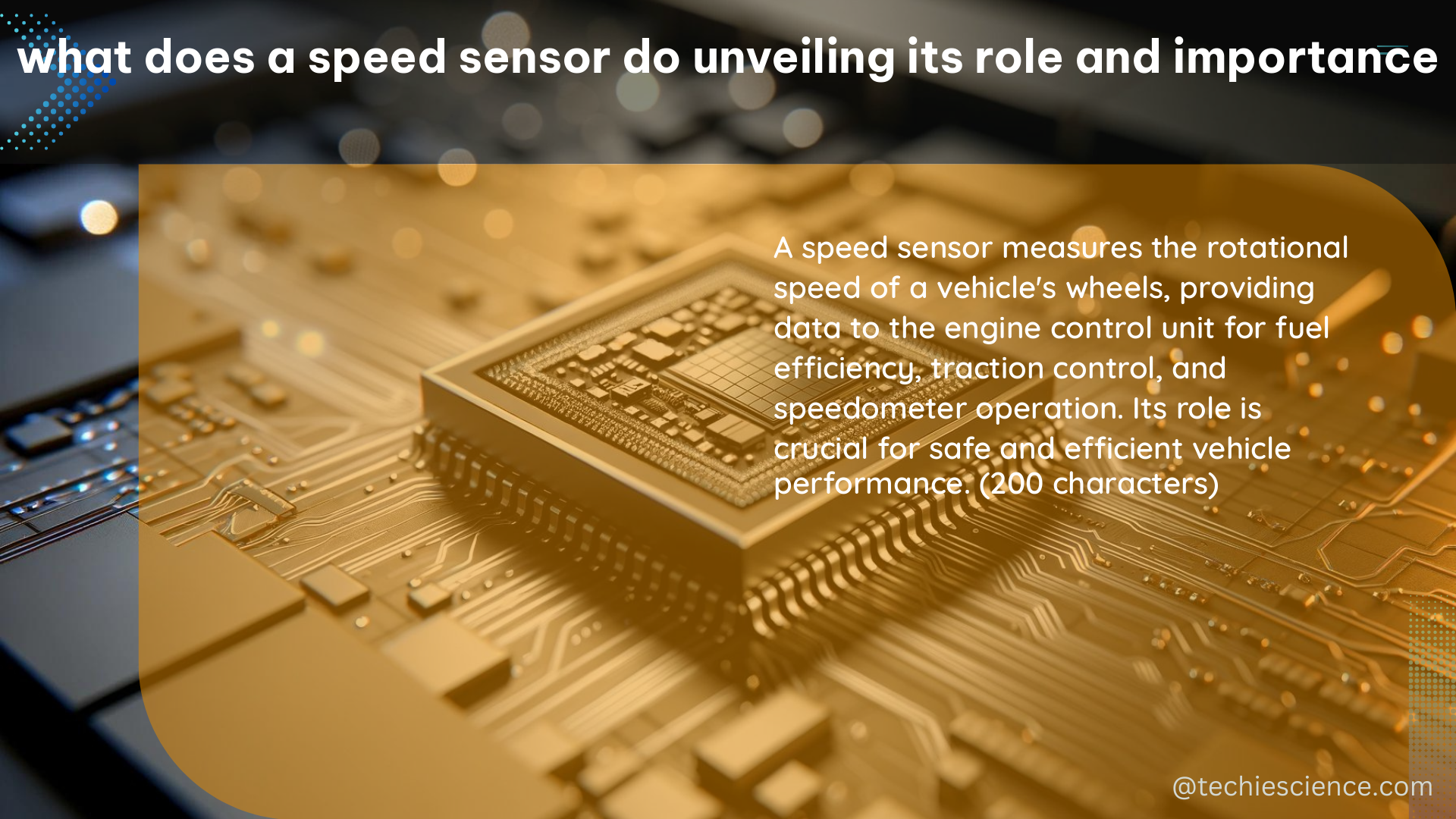A speed sensor is a critical component in various industries, including automotive, industrial, and aerospace, responsible for measuring the number of revolutions or distance traveled per unit of time. These sensors play a vital role in controlling processes, ensuring safety, optimizing performance, and enabling real-time decision-making.
Understanding the Fundamentals of Speed Sensors
Speed sensors are designed to detect the rotational speed or linear velocity of a moving object. They can be classified into two main types:
-
Inductive Speed Sensors: These sensors produce an AC analog wave, which varies in frequency proportional to the speed of the rotating object. They typically use a coil and a ferromagnetic core to generate a voltage signal as a metal target (e.g., gear teeth) passes by the sensor.
-
Digital Speed Sensors: These sensors generate a square wave output, with the frequency proportional to the speed of the moving object. They often use a Hall-effect or magnetoresistive technology to detect the presence of a magnetic field, which changes as the target (e.g., gear teeth or magnets) passes by the sensor.
The choice between inductive and digital speed sensors depends on the specific application requirements, such as the operating environment, speed range, and signal processing needs.
The Role of Speed Sensors in the Automotive Industry

In the automotive industry, speed sensors play a crucial role in various vehicle systems and functions:
Vehicle Speed Sensor (VSS)
The VSS is responsible for measuring the speed of the vehicle, providing this information to the vehicle’s control module. This data is then used to control devices such as the transmission shift solenoids and the speedometer. Without a properly functioning VSS, the speedometer and automatic transmission may experience issues.
Wheel Speed Sensors (WSS)
Wheel speed sensors are used for vehicle dynamics purposes, such as anti-lock brakes (ABS), stability control, and traction control. The ABS module monitors the speed of each wheel via the WSS, and during emergency braking, it uses this data to determine when to pulse the hydraulic pressure to the brakes, preventing wheel lockup.
Engine Speed Sensors
Engine speed sensors, also known as crankshaft position sensors, measure the rotational speed of the engine. This information is used by the engine control unit (ECU) to optimize fuel injection, ignition timing, and other engine management functions, ensuring efficient and reliable engine performance.
Transmission Speed Sensors
Transmission speed sensors monitor the rotational speed of the input and output shafts within the transmission. This data is used by the transmission control unit (TCU) to determine the appropriate gear selection and shift points, improving fuel efficiency and driving performance.
Advanced Applications of Speed Sensors
Beyond the automotive industry, speed sensors find applications in various other sectors:
Industrial Automation
In industrial settings, speed sensors are used to monitor the rotational speed of motors, conveyors, and other machinery. This information is crucial for process control, condition monitoring, and predictive maintenance, helping to optimize productivity and reduce downtime.
Aerospace and Defense
Speed sensors are essential in aerospace and defense applications, where they are used to measure the speed of aircraft, missiles, and other moving components. This data is critical for navigation, guidance, and control systems, ensuring the safety and performance of these high-speed, high-precision systems.
Renewable Energy
In wind turbine and hydroelectric power generation, speed sensors are used to monitor the rotational speed of the turbine blades or generator shafts. This information is used to optimize power generation, control blade pitch, and perform condition monitoring to maximize the efficiency and reliability of these renewable energy systems.
Advancements in Speed Sensor Technology
The speed sensor market has witnessed significant advancements in recent years, driven by the need for more accurate, reliable, and cost-effective solutions. Some of the key technological developments include:
-
Integrated Sensor Modules: Manufacturers are integrating multiple sensing capabilities, such as speed, position, and temperature, into a single compact module, simplifying installation and reducing the overall system complexity.
-
Wireless Speed Sensors: The emergence of wireless speed sensors, which eliminate the need for physical connections, has improved installation flexibility and reduced the risk of cable failures in harsh environments.
-
Intelligent Speed Sensors: Advanced speed sensors are incorporating microprocessors and digital signal processing capabilities, enabling features like self-diagnostics, adaptive signal processing, and advanced data analytics.
-
Sensor Fusion: By combining speed sensors with other types of sensors, such as accelerometers and gyroscopes, manufacturers are developing more comprehensive motion-sensing solutions for enhanced vehicle dynamics and control.
-
Miniaturization and Ruggedization: Ongoing advancements in materials, manufacturing, and packaging technologies have led to the development of smaller, more robust speed sensors that can withstand demanding operating conditions, such as high temperatures, vibrations, and harsh environments.
Conclusion
Speed sensors are essential components that play a pivotal role in various industries, particularly in the automotive sector. By accurately measuring the speed of moving objects, these sensors enable critical functions, such as vehicle dynamics control, engine management, and industrial process optimization. As technology continues to evolve, speed sensors are becoming more advanced, intelligent, and integrated, driving innovation and enhancing the safety, efficiency, and performance of a wide range of applications.
Reference:
- What is a Speed Sensor?
- Advances in Speed Sensor Technology for Automotive Applications
- What Does a Speed Sensor Do?
- The Importance of Speed Sensors in Automotive Applications
- Accelerating Innovation: Navigating the Speed Sensor Market

The lambdageeks.com Core SME Team is a group of experienced subject matter experts from diverse scientific and technical fields including Physics, Chemistry, Technology,Electronics & Electrical Engineering, Automotive, Mechanical Engineering. Our team collaborates to create high-quality, well-researched articles on a wide range of science and technology topics for the lambdageeks.com website.
All Our Senior SME are having more than 7 Years of experience in the respective fields . They are either Working Industry Professionals or assocaited With different Universities. Refer Our Authors Page to get to know About our Core SMEs.